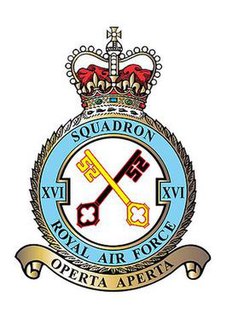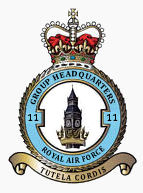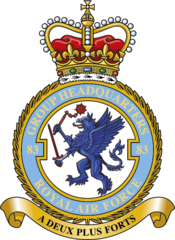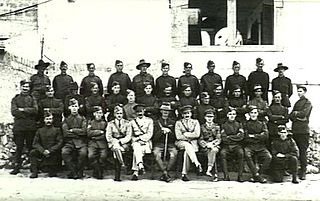
Marshal of the Royal Air Force (MRAF) is the highest rank in the Royal Air Force (RAF). In peacetime it was granted to RAF officers in the appointment of Chief of the Defence Staff (CDS), and to retired Chiefs of the Air Staff (CAS), who were promoted to it on their last day of service. While surviving Marshals of the RAF retain the rank for life, the highest rank to which officers on active service are promoted is now air chief marshal. Although general promotions to Marshal of the Royal Air Force have been discontinued since the British defence cuts of the 1990s, further promotions to the rank may still be made in wartime, for members of the Royal Family and certain very senior RAF air officers in peacetime at the discretion of the monarch; all such promotions in peacetime are only honorary, however. In 2012, Charles, Prince of Wales was promoted to the rank in recognition of his support for his mother, the Queen, in her capacity as head of the armed forces (commander-in-chief), while in 2014 Lord Stirrup, who had served as Chief of the Air Staff and Chief of the Defence Staff for over seven years, was also promoted.

Number 6 Squadron of the Royal Air Force operates the Eurofighter Typhoon FGR.4 at RAF Lossiemouth. It was previously equipped with the SEPECAT Jaguar GR.3 in the close air support and tactical reconnaissance roles, and was posted to RAF Coltishall, Norfolk until April 2006, moving to RAF Coningsby until disbanding for the first time in its history on 31 May 2007. The squadron officially reformed as a Typhoon squadron on 6 September 2010. No. 6 Squadron is unique in having two Royal standards, having been awarded its second one by King Abdullah I of Jordan in October 1950 due to its long period of service in the Middle East.

Number 16 Squadron, nicknamed the Saints, is a flying squadron of the Royal Air Force providing Elementary Flying Training (EFT) with the Grob Tutor T.1 from RAF Wittering.

No. 10 Group RAF was a former operations group of the Royal Air Force which participated in the Second World War.

No. 11 Group is a group in the Royal Air Force first formed in 1918. It had been formed and disbanded for various periods during the 20th century before disbanding in 1996 and reforming again in 2018. Its most famous service was in 1940 in the Battle of Britain during the Second World War, when it defended London and the south-east of the United Kingdom from attacks by the German Luftwaffe. It was reformed in late 2018 as a "multi-domain operations group" to ensure the service thinks and acts in a networked way.

No. 2 Group is a group of the Royal Air Force which was first activated in 1918, served from 1918–20, from 1936 through the Second World War to 1947, from 1948 to 1958, from 1993 to 1996, was reactivated in 2000, and is today part of Air Command.

The Central Flying School (CFS) is the Royal Air Force's primary institution for the training of military flying instructors. Established in 1912 at the Upavon Aerodrome, it is the longest existing flying training school. The school was based at RAF Little Rissington from 1946 to 1976. Its motto is Imprimis Praecepta, Latin for "The Teaching is Everlasting".

The Air Member for Personnel (AMP) is the senior Royal Air Force officer who is responsible for personnel matters and is a member of the Air Force Board. The AMP is in charge of all aspects of recruiting, non-operational flying and ground training, career management, welfare, terms, and conditions of service, and resettlement for RAF regular, reserve, and civilian staffs worldwide.

No. 83 Expeditionary Air Group is a group within the Royal Air Force, currently based at Al Udeid Air Base in Qatar.
The Deputy Chief of the Air Staff (DCAS) was a senior appointment in the Royal Air Force. The incumbent was the deputy to the Chief of the Air Staff. The post existed from 1918 to 1969. Today, the Chief of the Air Staff's deputy is titled as the Assistant Chief of the Air Staff.
No. 5 Wing of the Royal Air Force was a wing of aircraft squadrons which was originally established as the Fifth Wing of the Royal Flying Corps. Currently inactive, the wing has been formed and disbanded five times over the course of its history.

The Commandant of the Royal Observer Corps (CROC) was the Royal Air Force commander of the Royal Observer Corps. All the holders of the post were RAF officers in the rank of Air Commodore, initially retired reserve officers then Auxiliary officers and, since the end of World War II, serving officers. The ROC was a uniformed civilian branch initially under the control of the Air Defence of Great Britain organization, then Fighter Command and latterly Strike Command. The Royal Observer Corps existed from 1925 until it was stood down in 1995. Most of the commandants, with only three exceptions, were qualified RAF pilots, two being air navigators and the other a General Duties (Ground) Supply Branch officer. If a Royal Observer Corps officer had ever held the appointment, they would have held the rank of Observer Commodore.

No. 219 Squadron of the Royal Air Force was founded in 1918 and disbanded in 1957 after four separate periods of service. During the First World War it served as a coastal defence unit, and through most of the Second World War and the 1950s it operated as a night fighter air defence squadron. Three commanders of the squadron went on to be Chiefs of the Air Staff, two of the RAF and one of the Royal Pakistani Air Force.

No. 40 Wing formed part of the Royal Air Force (RAF) Palestine Brigade during World War I and immediately after. It was established in October 1917 as 40th (Army) Wing, Royal Flying Corps (RFC), and become part of the RAF in April 1918, when the RFC merged with the Royal Naval Air Service. The wing played a major part in the Battle of Megiddo, the last great offensive against the Ottoman Empire, in September 1918. It was disbanded in April 1920.
No. 41 Wing of the Royal Flying Corps (RFC), later the Royal Air Force (RAF), was a division which conducted strategic bombing operations against Germany during the First World War.
No. 205 Group was a long-range, heavy bomber group of the Royal Air Force (RAF) established on 23 October 1941 by boosting No. 257 Wing to Group status.
No. 15 Group was a group in the British Royal Air Force operational in the last year of World War I, and throughout World War II.
No. 46 Group RAF was a group of the Royal Air Force.
No. 2 Wing of the Royal Air Force was a wing of aircraft squadrons which was originally established as the Second Wing of the Royal Flying Corps.












